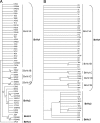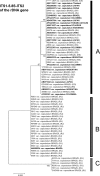Comparison of different DNA-based methods for molecular typing of Histoplasma capsulatum
- PMID: 20453140
- PMCID: PMC2897411
- DOI: 10.1128/AEM.02004-09
Comparison of different DNA-based methods for molecular typing of Histoplasma capsulatum
Abstract
Histoplasma capsulatum is very prevalent in the environment and is one of the most common causes of mycoses in humans and diverse animals in Brazil. Multiple typing methods have been developed to study H. capsulatum epidemiology; however, there is limited information concerning comparisons of results obtained with different methods using the same set of isolates. To explore the diversity of H. capsulatum in Brazil and to determine correlations between the results of three different molecular typing techniques, we examined 51 environmental, animal, and human isolates by M13 PCR fingerprinting, PCR-restriction fragment length polymorphism (RFLP) analysis of the internal transcribed region 1 (ITS1)-5.8S-ITS2 region of the rDNA locus, and DNA sequencing and phylogenetic analysis of parts of four protein-encoding genes, the Arf (ADP ribosylation factor), H-anti (H antigen precursor), Ole (delta-9 fatty acid desaturase), and Tub1 (alpha-tubulin) genes. Each method identified three major genetic clusters, and there was a high level of concordance between the results of the typing techniques. The M13 PCR fingerprinting and PCR-RFLP analyses produced very similar results and separated the H. capsulatum isolates included in this study into three major groups. An additional approach used was comparison of our Brazilian ITS1-5.8S-ITS2 sequences with the sequences deposited previously in NCBI data banks. Our analyses suggest that H. capsulatum can be divided into different molecular types that are dispersed around the world. Our results indicate that the three methods used in this study are reliable and reproducible and that they have similar sensitivities. However, M13 PCR fingerprinting has some advantages over the other two methods as it is faster, cheaper, and more user friendly, which especially increases its utility for molecular typing of Histoplasma in situations where laboratory facilities are relatively limited.
Figures



References
-
- Hamrick, J. L., R. W. Lichtwardt, and C. Lan. 1986. Levels of isozyme variation within and among Histoplasma capsulatum localities. Trans. Kans. Acad. Sci. 89:49-56. - PubMed
-
- Kasuga, T., T. J. White, G. Koenig, J. McEwen, A. Restrepo, E. Castaneda, C. Da Silva Lacaz, E. M. Heins-Vaccari, R. S. De Freitas, R. M. Zancope-Oliveira, Z. Qin, R. Negroni, D. A. Carter, Y. Mikami, M. Tamura, M. L. Taylor, G. F. Miller, N. Poonwan, and J. W. Taylor. 2003. Phylogeography of the fungal pathogen Histoplasma capsulatum. Mol. Ecol. 12:3383-3401. - PubMed
Publication types
MeSH terms
Substances
Associated data
- Actions
- Actions
- Actions
- Actions
- Actions
- Actions
- Actions
- Actions
- Actions
- Actions
- Actions
- Actions
- Actions
- Actions
- Actions
- Actions
- Actions
- Actions
- Actions
- Actions
- Actions
- Actions
- Actions
- Actions
- Actions
- Actions
- Actions
- Actions
- Actions
- Actions
- Actions
- Actions
- Actions
- Actions
- Actions
- Actions
- Actions
- Actions
- Actions
- Actions
- Actions
- Actions
- Actions
- Actions
- Actions
- Actions
- Actions
- Actions
- Actions
- Actions
- Actions
- Actions
- Actions
- Actions
- Actions
- Actions
- Actions
- Actions
- Actions
- Actions
- Actions
- Actions
- Actions
- Actions
- Actions
- Actions
- Actions
- Actions
- Actions
- Actions
- Actions
- Actions
- Actions
- Actions
- Actions
- Actions
- Actions
- Actions
- Actions
- Actions
- Actions
- Actions
- Actions
- Actions
- Actions
- Actions
- Actions
- Actions
- Actions
- Actions
- Actions
- Actions
- Actions
- Actions
- Actions
- Actions
- Actions
- Actions
- Actions
- Actions
- Actions
- Actions
- Actions
- Actions
- Actions
- Actions
- Actions
- Actions
- Actions
- Actions
- Actions
- Actions
- Actions
- Actions
- Actions
- Actions
- Actions
- Actions
- Actions
- Actions
- Actions
- Actions
- Actions
- Actions
- Actions
- Actions
- Actions
- Actions
- Actions
- Actions
- Actions
- Actions
- Actions
- Actions
- Actions
- Actions
- Actions
- Actions
- Actions
- Actions
- Actions
- Actions
- Actions
- Actions
- Actions
- Actions
- Actions
- Actions
- Actions
- Actions
- Actions
- Actions
- Actions
- Actions
- Actions
- Actions
- Actions
- Actions
- Actions
- Actions
- Actions
- Actions
- Actions
- Actions
- Actions
- Actions
- Actions
- Actions
- Actions
- Actions
- Actions
- Actions
- Actions
- Actions
- Actions
- Actions
- Actions
- Actions
- Actions
- Actions
- Actions
- Actions
- Actions
- Actions
- Actions
- Actions
- Actions
- Actions
- Actions
- Actions
- Actions
- Actions
- Actions
- Actions
- Actions
- Actions
- Actions
- Actions
- Actions
- Actions
- Actions
- Actions
- Actions
- Actions
- Actions
- Actions
- Actions
- Actions
- Actions
- Actions
- Actions
- Actions
- Actions
- Actions
- Actions
- Actions
- Actions
- Actions
- Actions
- Actions
- Actions
- Actions
- Actions
- Actions
- Actions
- Actions
- Actions
- Actions
- Actions
- Actions
- Actions
- Actions
- Actions
- Actions
- Actions
- Actions
- Actions
- Actions
- Actions
- Actions
- Actions
- Actions
- Actions
- Actions
- Actions
- Actions
- Actions
- Actions
- Actions
- Actions
- Actions
- Actions
- Actions
- Actions
- Actions
Grants and funding
LinkOut - more resources
Full Text Sources

